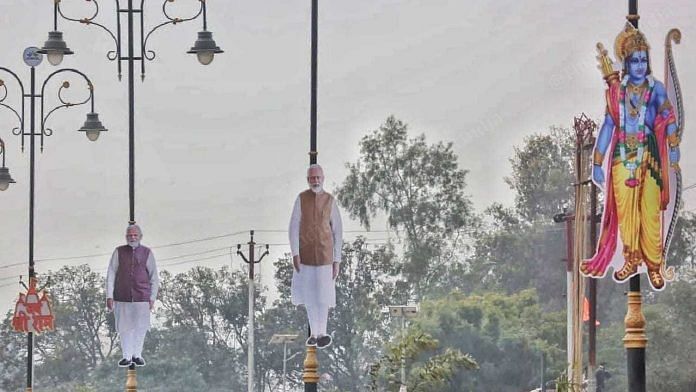Ayodhya: The devotees wait in neat, clearly demarcated lines at the Ram temple complex in Ayodhya, occasionally chanting ‘Jai Shri Ram’. Until a white woman wearing a tripundra tika on her forehead and an orange garland around her neck arrives, holding aloft her phone blaring techno-esque bhajans. The scene pivots. The crowd swells.
The remixed Raghupati Raghav Raja Ram was the elixir the devotees needed, and customary excitement contorted into something bordering on aggression. Devotion was on display for the world to see. The foreigner was the embodiment of the power and reach of Vishwaguru, a long-awaited import. A testament to Hindu India’s leadership, following quickly on G20’s footsteps and a collective admonishing of a country called the Maldives.
There’s a sense of fulfilment in the manic energy. Everyone is celebrating a kingdom reborn—with a 7-star hotel-rating. Ayodhya is the Prime Minister’s new postcard to the world. He can straddle the widest arc possible—from India’s longest bridge, Atal Setu, to the grandest temple, from yoga to bullet trains, from curing Hindu history wounds to talking peace with Putin and Netanyahu. And this hybridity is everywhere in the newly built temple town of Ayodhya.
Lavish claims are poised to encapsulate the temple town’s transformation: Ayodhya is due to be the world’s first AI-powered Vedic city and is responsible for the creation of the Vedic Sustainability Index. An MoU with Gurugram-based Aarhus Technologies was signed, and the first report will be out later this month. While details of the definition are yet to come into play, the use of seemingly contrary buzzwords marks the inflection. AI and sustainability are global principles suspended in a perennial state of formation—and Ayodhya might be too.
Finally, we get to see the fruits of 500 years of labour
In swaying with the Western woman’s dance moves, the Hindu devotees flocking to Ayodhya are revelling in the global appeal of their ancient religion. Their moment is now.
Land has been purchased by the biggest builders, and lofty pronouncements have been made—The Leela, Ayodhya, is due to be India’s first vegetarian 7-star hotel. All roads lead to Ayodhya. At its new airport, a screen flashes, and Bollywood actor Amitabh Bachchan announces the rebirth of a kingdom. Above a toll booth on national highway 330A from Rae Bareli to Ayodhya, a signboard talks about progress: ‘Ayodhya vikas sheher mein aapka swagat hai [Welcome to Ayodhya, the city of progress]’.
This is the end of Kalyug. This is what my father and grandfather fought for. They’re not here, but now their souls can rest in peace
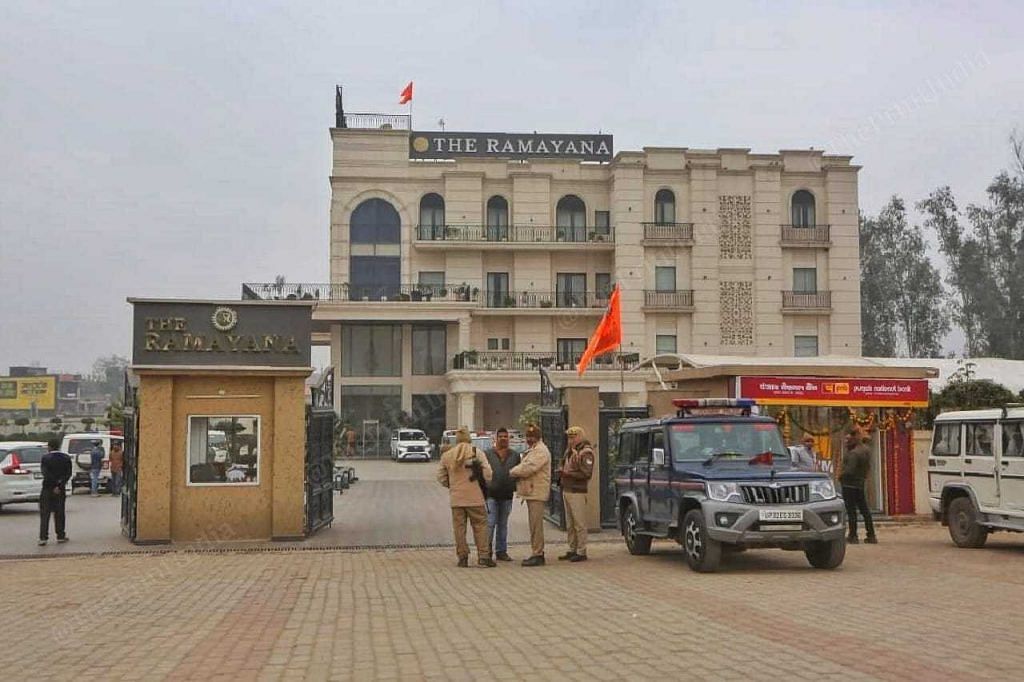
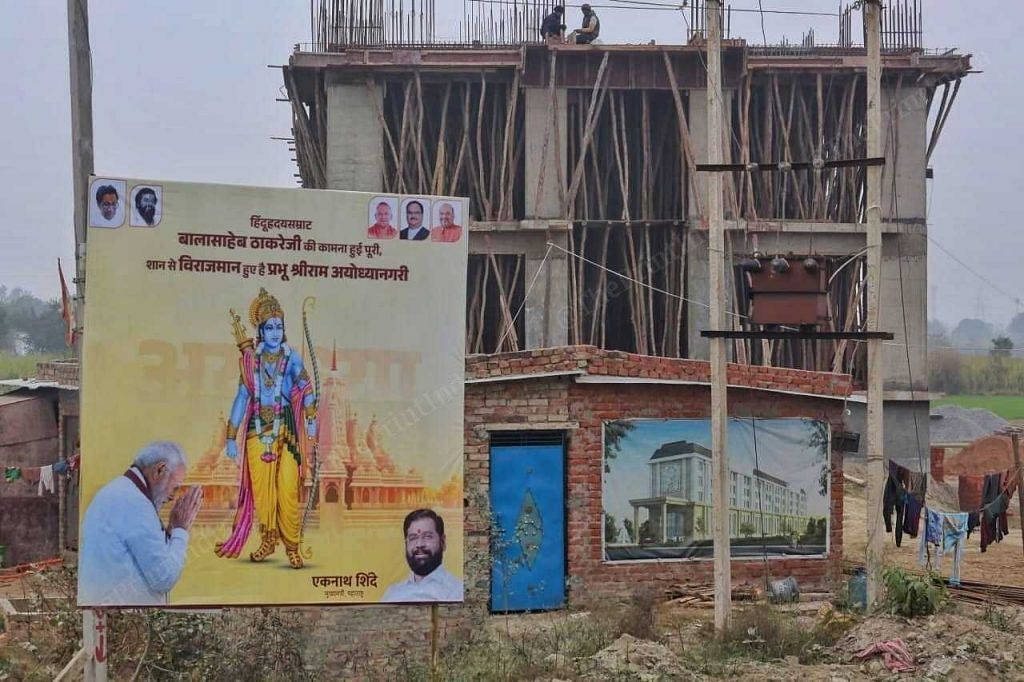
Gurbaksh Singh is in the thick of the action. His house is close to Lata Mangeshkar Chowk with its massive sitar that is supposed to be an ode to the late singer. It was virtually inaugurated by PM Narendra Modi last September. And Singh has been frequenting the chowk almost every day just to take it all in.
“I was supposed to go abroad on 3 January, but now I’ve changed my ticket to the 24th. This is the end of Kalyug. This is what my father and grandfather fought for,” he says, ecstatically. “They’re not here, but now their souls can rest in peace.”
It’s a sentiment echoed by almost everyone. The fervid atmosphere will come to a head on 22 January, the day of the temple’s consecration, but for many, it signals the beginning. What was meant to be a period at the end of a 500-year-long wait for Hindu civilisation is actually neither a climax nor a culmination. For devotees, it’s the beginning of a brave new world.
“Finally, we get to see the fruits of 500 years of labour,” says a local resident, Pushp Lata, jubilantly, referring to the widely believed history of the destruction of a temple by Mughal emperor Babur in the 17th century, said to be the birthplace of Ram. “And now I will keep coming.”
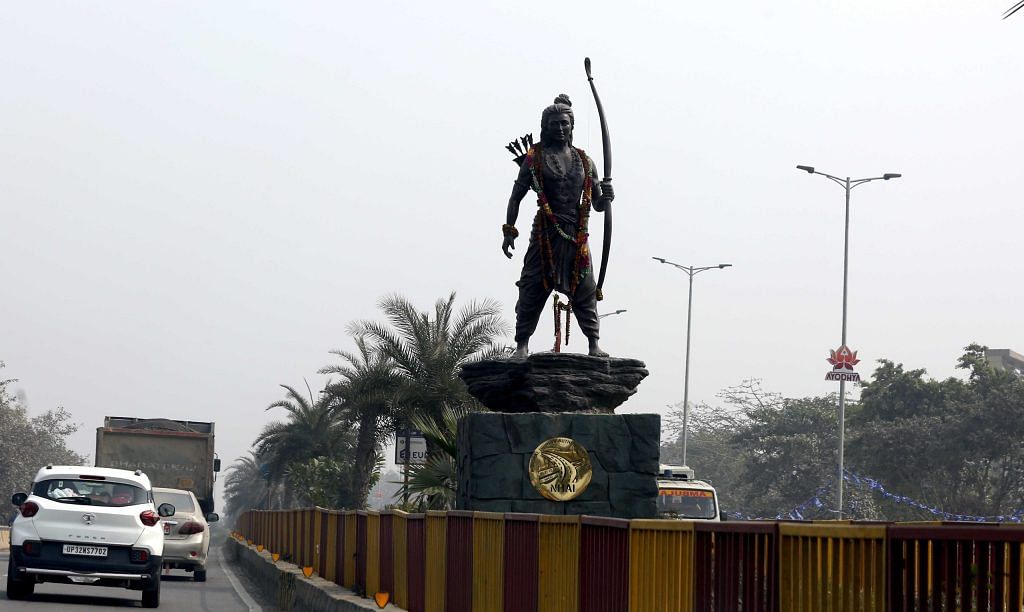
She walks towards the temple complex. The fact that it’s unfinished and yet to be opened with the scaffolding visible even from a distance makes no difference to her. Ram Lalla wasn’t just born in the mandir; he supposedly also frequented outside areas, she says.
In the grand Ayodhya makeover, old streets are unrecognisable. The roads have been made fit to accommodate a fleet of SUVs. Drivers easily get lost because new roads are springing up every few days. And the old roads have new names. What is now Ram Path, Dharam Path, Bhakti Path all simply used to be known as Sahadatganj Road.
“Everything is going to be built. I don’t think they’re going to let us live here. I have land next to the airport, but I can’t sell it. The government and politicians are going to capture it all,” says Suraj Yadav, who works as a driver. “Work might get better, though.”
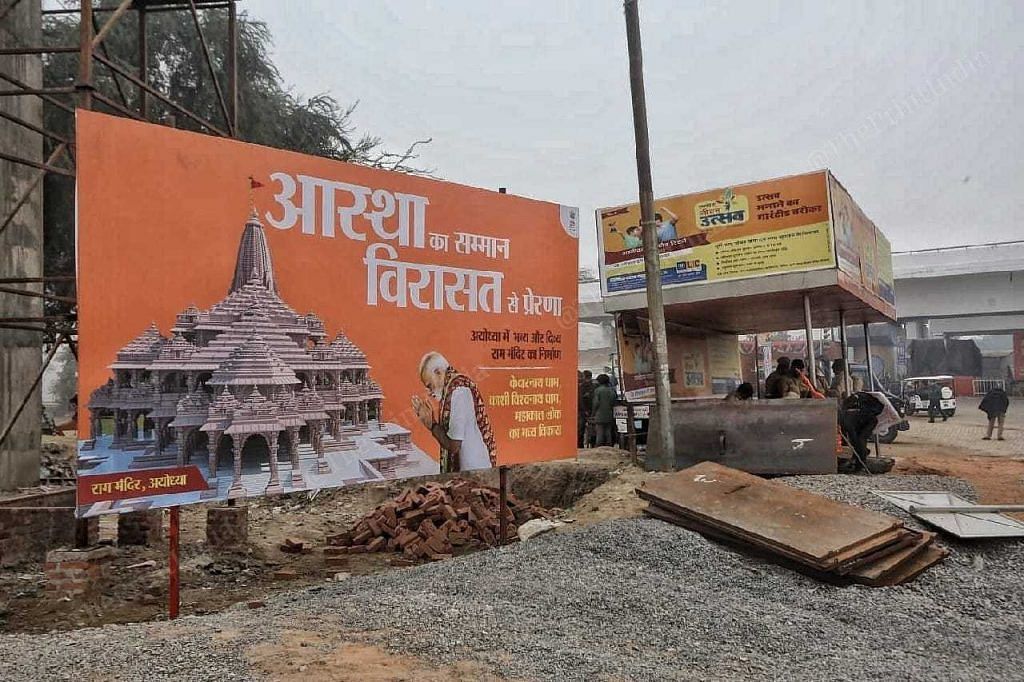
Every solar-powered lamp post has a speaker blaring out different Ram Bhajans all day. It’s a cacophony of bhajans. And then there’s added pleasure from bhajans that emanate from the e-buses. In the run-up to 22 January, a Ram-leela is taking place daily.
“This energy will continue. We’ll keep coming back and forth,” declares Poonam, a saffron-clad female priest.
Also read: Ram temple in Reels—a massive project is on to make Ayodhya cool
Insta crowd has come, waiting for the rich
For decades, Ayodhya was a sort of disturbed ground enveloped in a hush. Now, there’s a prideful air of exaltation that pervades the streets. Outside the Hanuman Garhi temple, devotees spontaneously erupt into chants of ‘Jai Shri Ram’. Young girls jostle their way into crowds, attempting to put stenciled tikas that spell ‘Jai Siya Ram’ on anyone they can get hold of. It’s the potential of promise. The job is done, and now the celebration can last for all eternity.
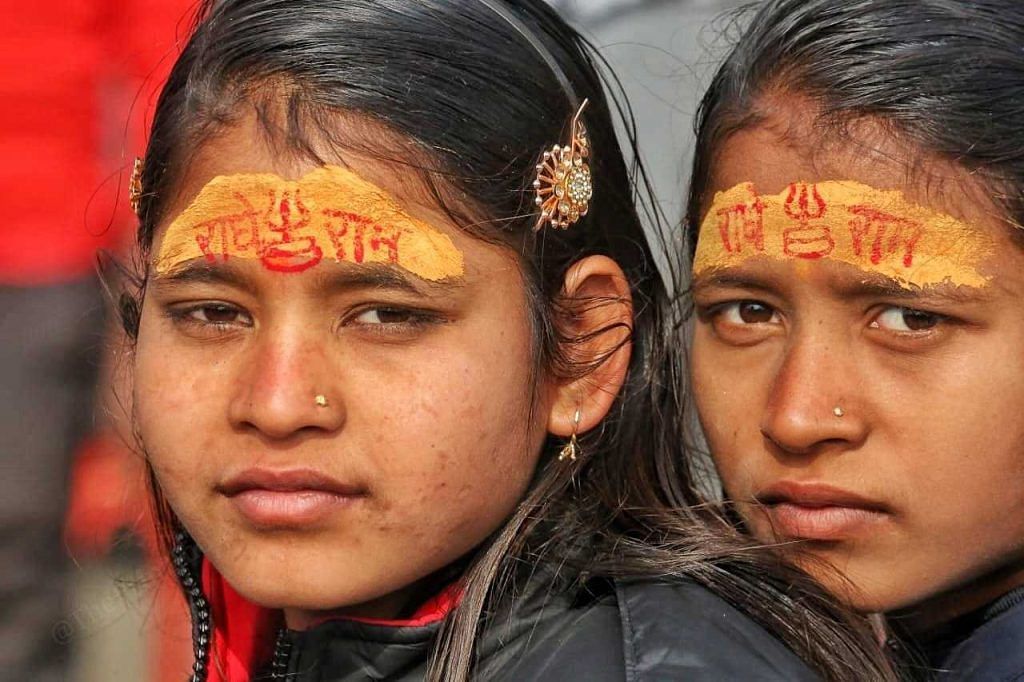
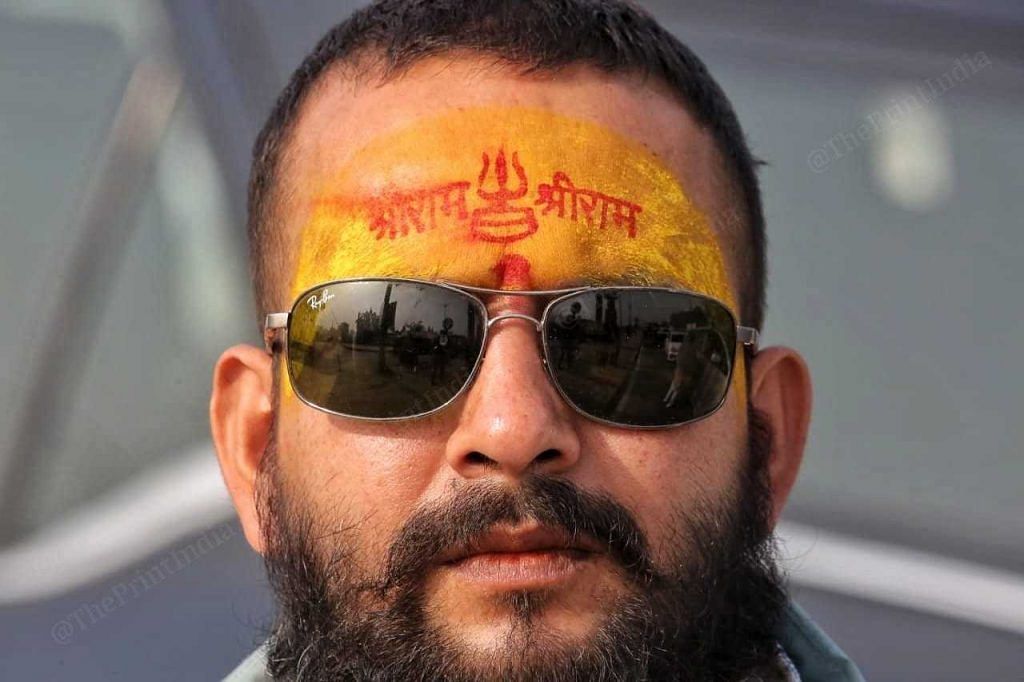
But still, Hanuman isn’t Ram. “Why did you bring me here? This is fine, but I wanted to see the Ram temple,” a woman from Bikaner admonishes her husband.
The houses and shops are saffron. The homogeneity persists outside as well, where cream-coloured walls are edged with orange.
Swati Gupta sits slouching, her expression bored. There are no lines of tourists clamouring to enter shops. “Nothing is selling, and now they’re erecting barricades,” she says, pointing to a man drilling a hole onto the pavement. She has done her due diligence by selling Ram Mandir merch. Little bronze temples are stacked up right in front of idols of a blue toddler Ram, and according to her, it’s what all shopkeepers are going to shift to.
Everything is going to be built. I don’t think they’re going to let us live here. I have land next to the airport, but I can’t sell it. The government and politicians are going to capture it all
There’s an idol of Ram in a Jockey store on Hanuman Garhi next to mini half mannequins in men’s underwear. He looms large—and wide, and muscular, and sometimes calm and serene. But representations of Ram Lalla—infant Ram—are few and far between.
Everything hinges on the arrival of people. It’s not dissimilar from what’s transpiring within the temple town. Ornate solar lamps litter Ram Path, a 13-kilometre corridor that leads to the Ram Mandir. A beautification drive is underway, and a rumoured 25,000 flower pots are being ferried—simply for decorative purposes. Over Rs 30,000 crore have been spent. It’s a town holding its breath for greatness.
The tourists currently enjoying Ayodhya are unfazed by the infrastructural projects set to alter perceptions of religious tourism. They’re unbothered by soaring land prices, the potential of rising stocks, and the apparent joy of electric vehicles. Even pink Uber autos. They aren’t luxuriating in the changes and are far more immersed in the mandir’s coming-of-age.
“We live in Lucknow, but my husband has an office here. We decided to come for the day—to see the mandir,” says a woman strolling outside the temple complex. The couple won’t be going anywhere else.
The big rush of crowds will come. But the real win is if the rich and the affluent arrive. That will indicate if Hinduism has been made trendy and Instagrammable by the BJP.
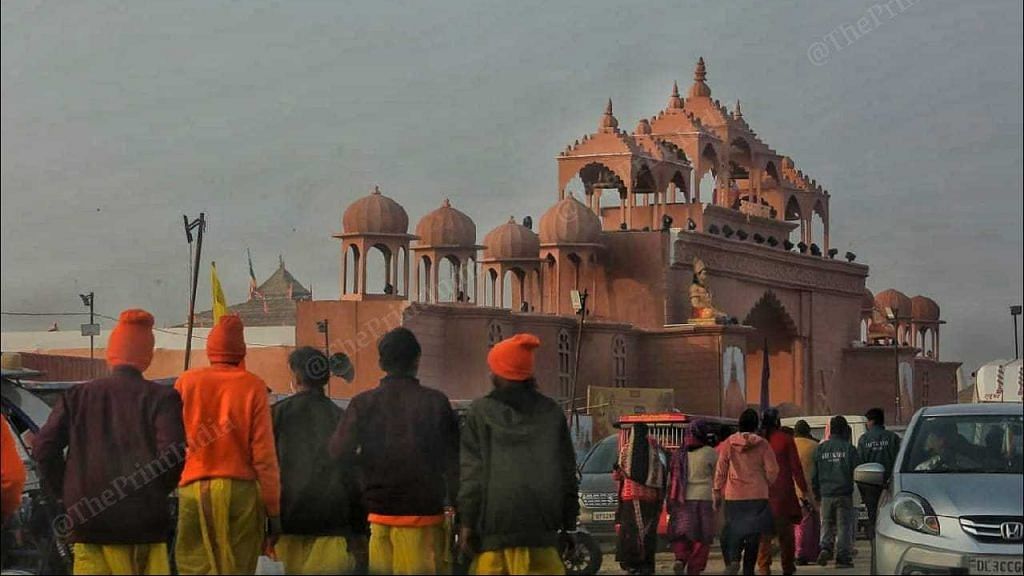
Hotels, eateries befitting of the hotels, a theme park, a zoological park, perhaps a Central Park-esque green corridor as the nucleus of the city—all are in the works. And as the saying goes: if you build it, they will come.
The mandir is an avowal, a surety that people will come. But for the legion of urban planners on the job, it needs to serve as a spark and open the floodgates. The goal, according to officials, is a 3-4 day itinerary. The temple must be experienced while staying in one of several upmarket hotels, to snack on the kiosks along the Saryu River, and if one is feeling audacious––maybe even purchase a plot of land.
This is far from how things used to be. “This was the poor people’s fair,” says a Faizabad resident who did not want to be named. People from villages around the state would come to celebrate the monsoon. Now all has been forgotten. A 21st century temple town needs 21st century inhabitants.
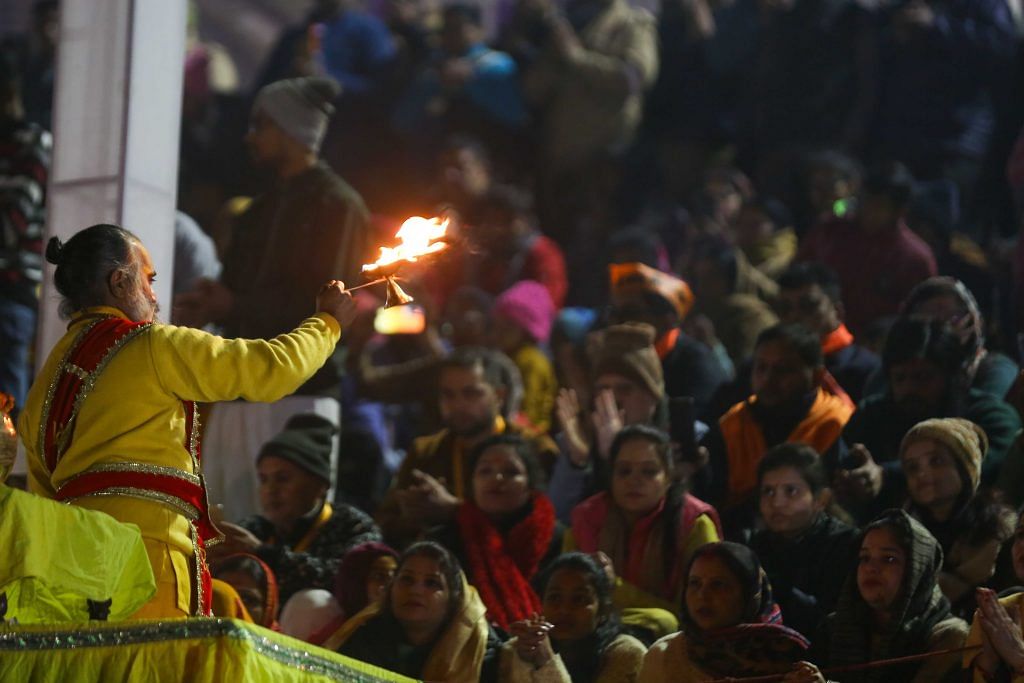
“During festivals particularly, we can see the class changing. Ritzier tourists come. We need that class. The Ayodhya economy depends on it,” says an official in the Ayodhya Development Authority. “Except tourism, there’s nothing here. We need it to be a major economic hub.”
The Ramayana, the now non-bloody history of Ayodhya––the sacrifices, the ‘injustices meted out to Hindus’—need to be introduced to a new generation. But what exactly is being imbibed is uncertain. Outside the gleaming neon sign of Ayodhya Haat, a group of young men, who belligerently remain in sunglasses even though the sun has long set, stop their speeding car. They rush out, take photographs outside the sign, return to their car, and drive away. Mission accomplished.
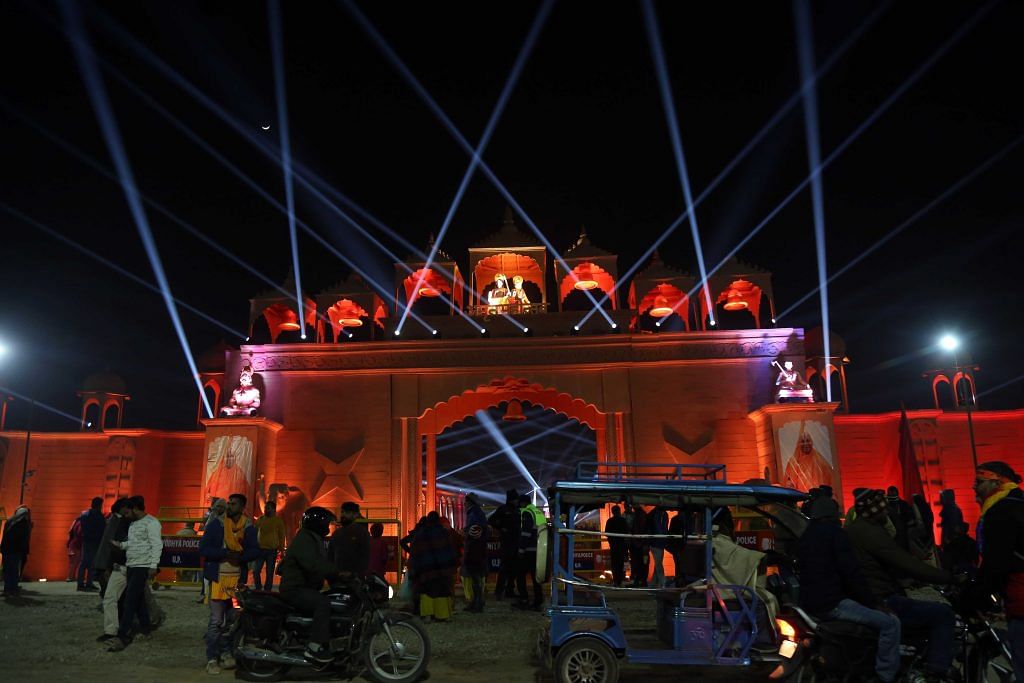
Selfie-mania is now an inextricable part of the Indian psyche, starting from the top. What began as the trend of Modi selfies in 2014 is concluding India’s transformative decade with an Ayodhya selfie. And the jarring mix of a sitar dedicated to a late singer, neon signs, and scenes from the Ramayana are perfect for its consummation.
“People are taking selfies here till 2 am,” sighs a resident, looking on from Lata Mangeshkar Chowk.
A couple of metres away, a group of earnest priests in saffron robes sit by the roadside, clutching books in their hands, trying to attract the attention of easily distracted tourists and local people. They swear they aren’t part of any religious body, and are just doing god’s work, which involves distributing one lakh copies of the Yatharth Geeta—a Bhagavad Gita for non-Hindus—translated from Sanskrit to Hindi. This is their ideal setting. “After all, everyone is here only to pray,” says one of the priests, Prabhu Srivastava, before stopping two women from almost stepping on the books laid out on the street.
But the priests can’t compete with the man in a velvet turban who has just arrived, dripping in gold. His orange sunglasses are overshadowed by his bedazzled headgear and mask. The crowd cheers as he saunters up to them. In this carnival-like atmosphere, interest in Yatharth Geeta has visibly dimmed.
Ayodhya is teeming with the pious, the party-goers, and the performers, all of whom want to be part of this cultural moment in India’s history.
Also read: Congress boycott right. Ayodhya event not about Ram, but coronates Hindutva as state religion
Representations of Ram
Ram is a new mascot, but it’s a more muscular rendition on display. He is on various hoardings, but always either next to, above, or beside PM Modi. In some, Modi defers to Ram—bowing down in front of him. Modi below, Ram above him. The duo is everywhere, often accompanied by other BJP leaders, with Uttar Pradesh Chief Minister Yogi Adityanath leading the pack.
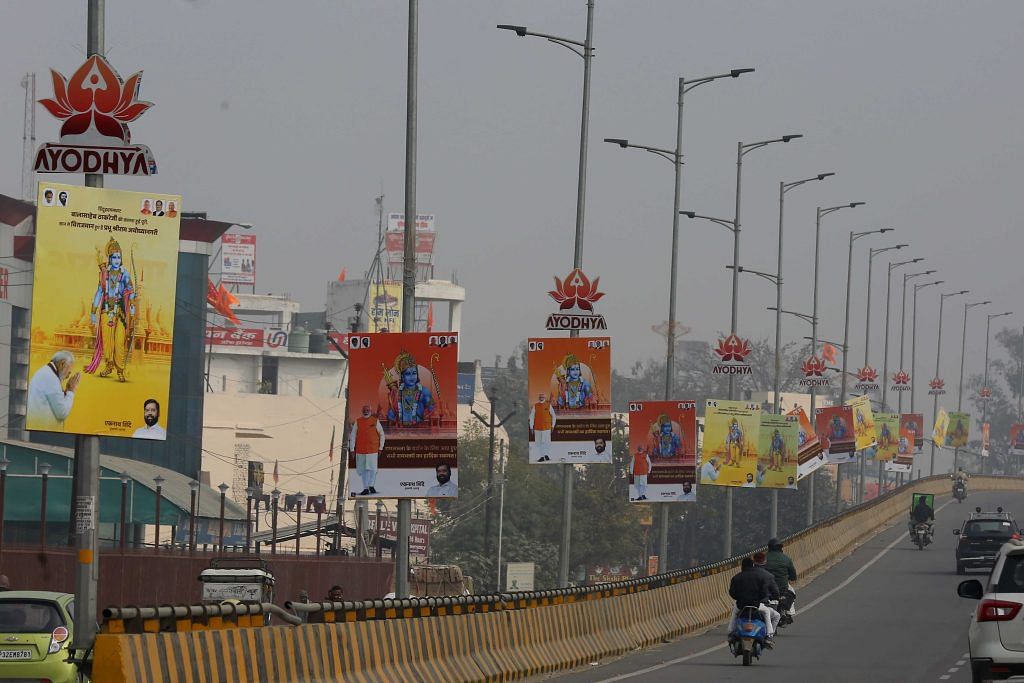
In the consecration hoarding, peppered around the ‘up and coming’ town, Ram is painted blue with a red tilak on his forehead, shooting an arrow with a focussed expression. His many jewels are straining against his biceps. Then there’s the mandir, slightly blurry and sepia toned—as if out of a dream. A hoarding of Madhusudhan tea and desi ghee is strategically placed below it. Bank of Baroda, Utkarsh Small Finance Bank, Mangaldeep Agarbattis—everyone seems to want a piece of the pie. And so, the town is teeming with advertisements. But only one company, Madhusudhan, has prime real-estate.
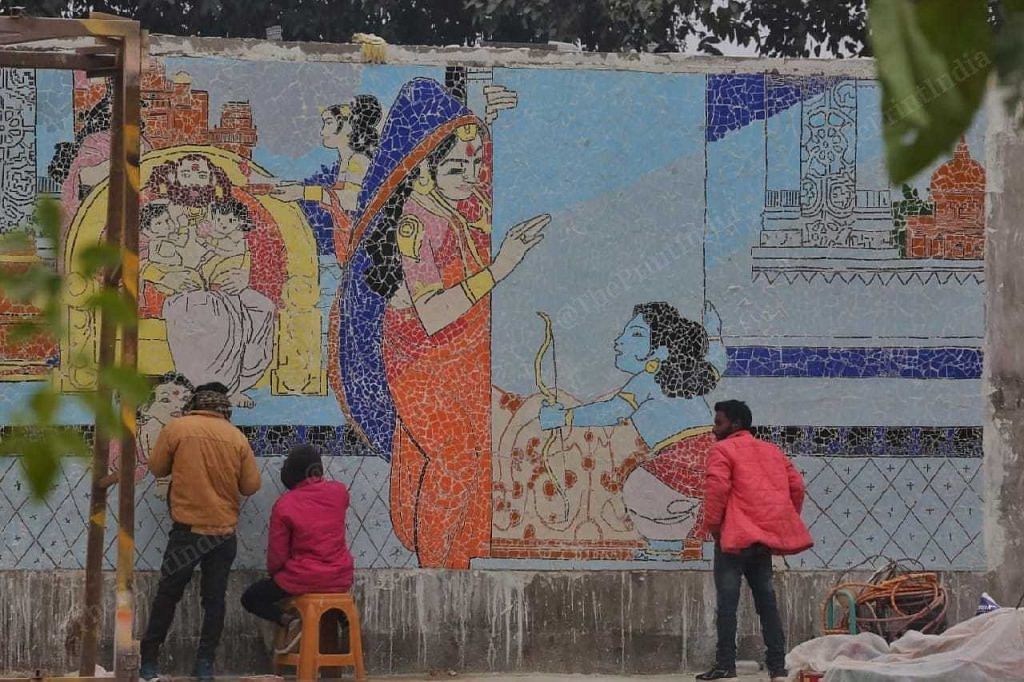
The new Paths leading to the mandir will be lined with 82 murals narrating the Ramayana to a generation of Indians who may have missed Doordarshan’s 1987 show or the 1992 anime. Currently, it’s a half-finished project, and only has a one-way road with police checkpoints. Some mosaics and terracotta pieces are on display, but most hoardings are empty. According to officials, about 7-8 artists have been commissioned from various parts of the country, and made to adhere to a certain account of the Ramayana. There’s supposed to be a QR code that takes observers to a payment page, so they can buy prints.
It’s the homecoming of Ram that is being celebrated, not the Ramayana. For many, their god is coming back after “500 years of exile”. And this time, cut-outs of politicians are lined up to welcome him.
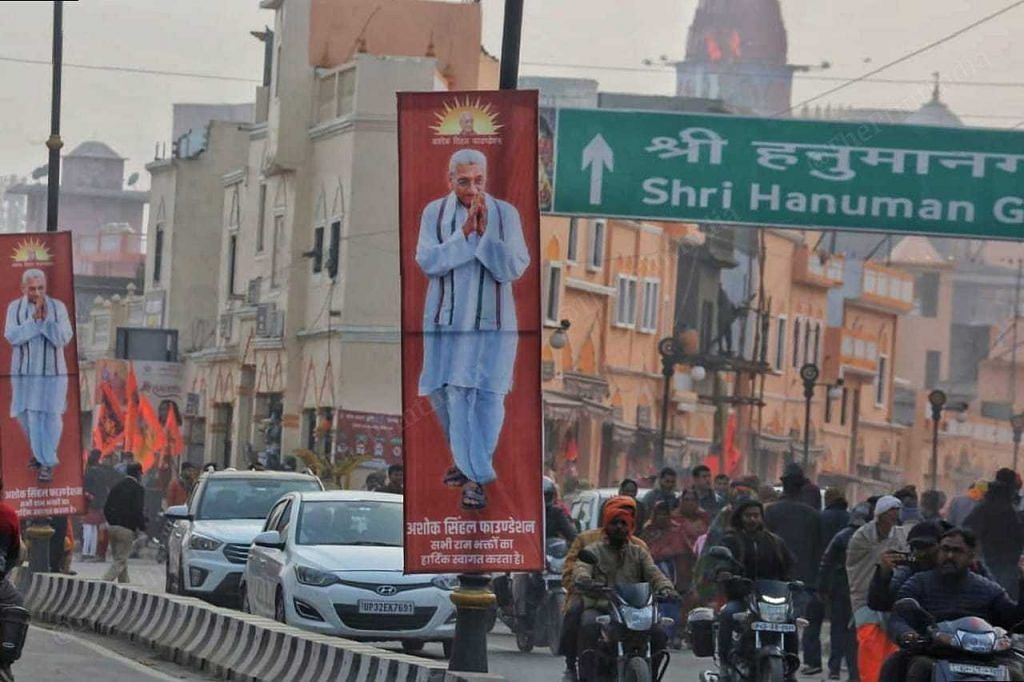
On the grounds of Naya Ghat, a temple complex less immersed in the politics that has built new India, there’s a rangoli of Ram and Sita, walking hand-in-hand, into the glory of the temple. The temple is now a flaming orange-red colour, with a crown of red flags. An Instagram logo and ID has also been carved into the piece. It’s new-age religious marketing. Publicity is important, even if the purpose is holy.
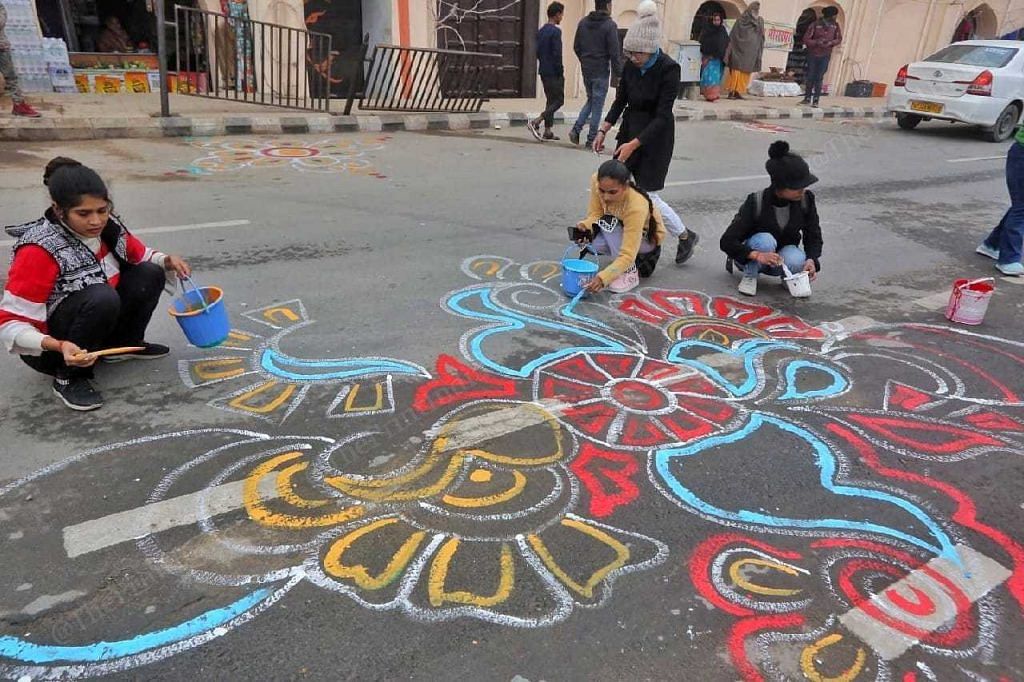
Also read: Ayodhya is being rebooted, rebuilt, & reimagined— Gen Z pilgrims, luxury hotels, 3D shows
The flag is fluttering
The ‘return’ of Ram, the consecration of the mandir, and the subsequent surge in spiritual tourism—OYO has announced opening 400 properties across religious centres, including Ayodhya and Tirupati—is the enmeshing of Hindu culture and capital. It’s Hinduism as projected to the world, defined and dictated by a PM who is equal parts RSS and technocrat.
If Ayodhya is a compressed version of Hindu Rashtra, then it’s clearly brimming with possibilities. The entire city is plastered with pledges: “Modi Sarkaar ki guarantee.” Free healthcare for poor people, functional water-taps in all houses, cyber safety, women’s safety—the list goes on. Modi smiles beatifically next to what appears to be a bullet train Vande Bharat, next to a railway station that resembles an airport.
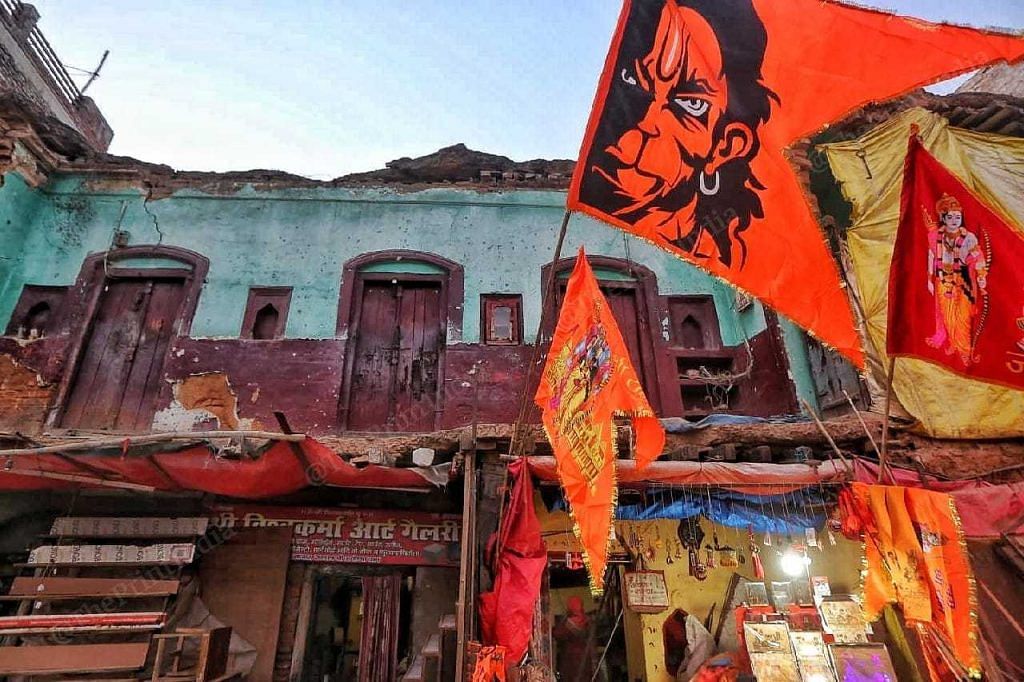
There are three kinds of saffron flags to be found all over the city––one depicts Ram and the temple, another has the black-lined Hanuman that is the Bajrang Dal’s logo, and the third is the BJP flag. All three are available in almost every shop. Rajesh Gupta sold water and cold drinks at his shop in Hanuman Garhi, but as of last week, he sells flags. “All the shops have started selling flags now. I still sell water, but now I keep the bottles at the back,” he says.
(Edited by Prashant)


